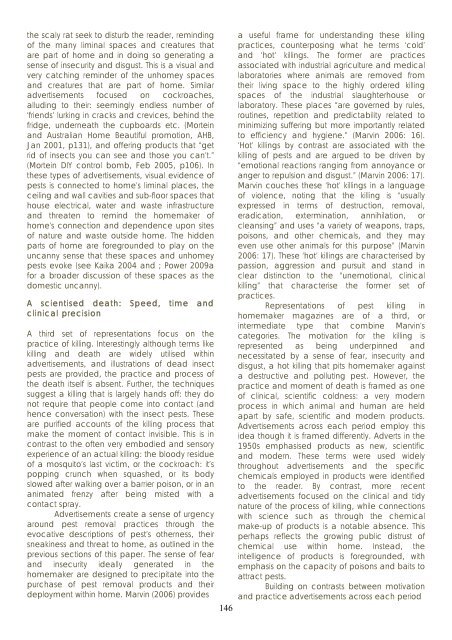Marketing Animals - Antennae The Journal of Nature in Visual Culture
Marketing Animals - Antennae The Journal of Nature in Visual Culture
Marketing Animals - Antennae The Journal of Nature in Visual Culture
Create successful ePaper yourself
Turn your PDF publications into a flip-book with our unique Google optimized e-Paper software.
the scaly rat seek to disturb the reader, rem<strong>in</strong>d<strong>in</strong>g<br />
<strong>of</strong> the many lim<strong>in</strong>al spaces and creatures that<br />
are part <strong>of</strong> home and <strong>in</strong> do<strong>in</strong>g so generat<strong>in</strong>g a<br />
sense <strong>of</strong> <strong>in</strong>security and disgust. This is a visual and<br />
very catch<strong>in</strong>g rem<strong>in</strong>der <strong>of</strong> the unhomey spaces<br />
and creatures that are part <strong>of</strong> home. Similar<br />
advertisements focused on cockroaches,<br />
allud<strong>in</strong>g to their: seem<strong>in</strong>gly endless number <strong>of</strong><br />
‘friends’ lurk<strong>in</strong>g <strong>in</strong> cracks and crevices, beh<strong>in</strong>d the<br />
fridge, underneath the cupboards etc. (Morte<strong>in</strong><br />
and Australian Home Beautiful promotion, AHB,<br />
Jan 2001, p131), and <strong>of</strong>fer<strong>in</strong>g products that “get<br />
rid <strong>of</strong> <strong>in</strong>sects you can see and those you can’t.”<br />
(Morte<strong>in</strong> DIY control bomb, Feb 2005, p106). In<br />
these types <strong>of</strong> advertisements, visual evidence <strong>of</strong><br />
pests is connected to home’s lim<strong>in</strong>al places, the<br />
ceil<strong>in</strong>g and wall cavities and sub-floor spaces that<br />
house electrical, water and waste <strong>in</strong>frastructure<br />
and threaten to rem<strong>in</strong>d the homemaker <strong>of</strong><br />
home’s connection and dependence upon sites<br />
<strong>of</strong> nature and waste outside home. <strong>The</strong> hidden<br />
parts <strong>of</strong> home are foregrounded to play on the<br />
uncanny sense that these spaces and unhomey<br />
pests evoke (see Kaika 2004 and ; Power 2009a<br />
for a broader discussion <strong>of</strong> these spaces as the<br />
domestic uncanny).<br />
A scientised death: Speed, time and<br />
cl<strong>in</strong>ical precision<br />
A third set <strong>of</strong> representations focus on the<br />
practice <strong>of</strong> kill<strong>in</strong>g. Interest<strong>in</strong>gly although terms like<br />
kill<strong>in</strong>g and death are widely utilised with<strong>in</strong><br />
advertisements, and illustrations <strong>of</strong> dead <strong>in</strong>sect<br />
pests are provided, the practice and process <strong>of</strong><br />
the death itself is absent. Further, the techniques<br />
suggest a kill<strong>in</strong>g that is largely hands <strong>of</strong>f: they do<br />
not require that people come <strong>in</strong>to contact (and<br />
hence conversation) with the <strong>in</strong>sect pests. <strong>The</strong>se<br />
are purified accounts <strong>of</strong> the kill<strong>in</strong>g process that<br />
make the moment <strong>of</strong> contact <strong>in</strong>visible. This is <strong>in</strong><br />
contrast to the <strong>of</strong>ten very embodied and sensory<br />
experience <strong>of</strong> an actual kill<strong>in</strong>g: the bloody residue<br />
<strong>of</strong> a mosquito’s last victim, or the cockroach: it’s<br />
popp<strong>in</strong>g crunch when squashed, or its body<br />
slowed after walk<strong>in</strong>g over a barrier poison, or <strong>in</strong> an<br />
animated frenzy after be<strong>in</strong>g misted with a<br />
contact spray.<br />
Advertisements create a sense <strong>of</strong> urgency<br />
around pest removal practices through the<br />
evocative descriptions <strong>of</strong> pest’s otherness, their<br />
sneak<strong>in</strong>ess and threat to home, as outl<strong>in</strong>ed <strong>in</strong> the<br />
previous sections <strong>of</strong> this paper. <strong>The</strong> sense <strong>of</strong> fear<br />
and <strong>in</strong>security ideally generated <strong>in</strong> the<br />
homemaker are designed to precipitate <strong>in</strong>to the<br />
purchase <strong>of</strong> pest removal products and their<br />
deployment with<strong>in</strong> home. Marv<strong>in</strong> (2006) provides<br />
146<br />
a useful frame for understand<strong>in</strong>g these kill<strong>in</strong>g<br />
practices, counterpos<strong>in</strong>g what he terms ‘cold’<br />
and ‘hot’ kill<strong>in</strong>gs. <strong>The</strong> former are practices<br />
associated with <strong>in</strong>dustrial agriculture and medical<br />
laboratories where animals are removed from<br />
their liv<strong>in</strong>g space to the highly ordered kill<strong>in</strong>g<br />
spaces <strong>of</strong> the <strong>in</strong>dustrial slaughterhouse or<br />
laboratory. <strong>The</strong>se places “are governed by rules,<br />
rout<strong>in</strong>es, repetition and predictability related to<br />
m<strong>in</strong>imiz<strong>in</strong>g suffer<strong>in</strong>g but more importantly related<br />
to efficiency and hygiene.” (Marv<strong>in</strong> 2006: 16).<br />
‘Hot’ kill<strong>in</strong>gs by contrast are associated with the<br />
kill<strong>in</strong>g <strong>of</strong> pests and are argued to be driven by<br />
“emotional reactions rang<strong>in</strong>g from annoyance or<br />
anger to repulsion and disgust.” (Marv<strong>in</strong> 2006: 17).<br />
Marv<strong>in</strong> couches these ‘hot’ kill<strong>in</strong>gs <strong>in</strong> a language<br />
<strong>of</strong> violence, not<strong>in</strong>g that the kill<strong>in</strong>g is “usually<br />
expressed <strong>in</strong> terms <strong>of</strong> destruction, removal,<br />
eradication, exterm<strong>in</strong>ation, annihilation, or<br />
cleans<strong>in</strong>g” and uses “a variety <strong>of</strong> weapons, traps,<br />
poisons, and other chemicals, and they may<br />
even use other animals for this purpose” (Marv<strong>in</strong><br />
2006: 17). <strong>The</strong>se ‘hot’ kill<strong>in</strong>gs are characterised by<br />
passion, aggression and pursuit and stand <strong>in</strong><br />
clear dist<strong>in</strong>ction to the “unemotional, cl<strong>in</strong>ical<br />
kill<strong>in</strong>g” that characterise the former set <strong>of</strong><br />
practices.<br />
Representations <strong>of</strong> pest kill<strong>in</strong>g <strong>in</strong><br />
homemaker magaz<strong>in</strong>es are <strong>of</strong> a third, or<br />
<strong>in</strong>termediate type that comb<strong>in</strong>e Marv<strong>in</strong>’s<br />
categories. <strong>The</strong> motivation for the kill<strong>in</strong>g is<br />
represented as be<strong>in</strong>g underp<strong>in</strong>ned and<br />
necessitated by a sense <strong>of</strong> fear, <strong>in</strong>security and<br />
disgust, a hot kill<strong>in</strong>g that pits homemaker aga<strong>in</strong>st<br />
a destructive and pollut<strong>in</strong>g pest. However, the<br />
practice and moment <strong>of</strong> death is framed as one<br />
<strong>of</strong> cl<strong>in</strong>ical, scientific coldness: a very modern<br />
process <strong>in</strong> which animal and human are held<br />
apart by safe, scientific and modern products.<br />
Advertisements across each period employ this<br />
idea though it is framed differently. Adverts <strong>in</strong> the<br />
1950s emphasised products as new, scientific<br />
and modern. <strong>The</strong>se terms were used widely<br />
throughout advertisements and the specific<br />
chemicals employed <strong>in</strong> products were identified<br />
to the reader. By contrast, more recent<br />
advertisements focused on the cl<strong>in</strong>ical and tidy<br />
nature <strong>of</strong> the process <strong>of</strong> kill<strong>in</strong>g, while connections<br />
with science such as through the chemical<br />
make-up <strong>of</strong> products is a notable absence. This<br />
perhaps reflects the grow<strong>in</strong>g public distrust <strong>of</strong><br />
chemical use with<strong>in</strong> home. Instead, the<br />
<strong>in</strong>telligence <strong>of</strong> products is foregrounded, with<br />
emphasis on the capacity <strong>of</strong> poisons and baits to<br />
attract pests.<br />
Build<strong>in</strong>g on contrasts between motivation<br />
and practice advertisements across each period












